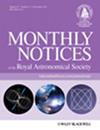太阳爆发缓慢上升阶段的解释
IF 4.8
3区 物理与天体物理
Q1 ASTRONOMY & ASTROPHYSICS
引用次数: 0
摘要
太阳爆发是日冕准静态演化过程中积累的磁自由能的突然释放。有趣的是,许多太阳爆发之前都有一个短期的缓慢上升阶段,在此期间,爆发前结构的上升速度明显大于准静态演化的速度。在此,我们根据最近对太阳爆发起始阶段进行的高精度磁流体力学模拟,提出了对缓慢上升阶段的解释。模拟显示,通过持续剪切双极磁弧,内部电流片逐渐形成,一旦在电流片上触发磁重联,爆发就开始了。我们在模拟中发现,在重联开始之前,上覆磁场呈现缓慢上升阶段。此外,在这一阶段,上升速度明显大于核心磁场的上升速度。这种缓慢上升是弧场在接近完全开放场状态过程中不断膨胀的表现,而这正是爆发前形成电流片的内在原因。我们还展示了三个具有缓慢上升阶段的耀斑事件,它们与模拟中的这些关键特征高度一致:上覆日冕环的膨胀速度远大于准静态演化速度;对于那些有灯丝喷发的事件,灯丝的缓慢上升远小于上覆日冕环的缓慢上升。在这类事件中,爆发可能是通过模拟所示的机制开始的,而上覆日冕环的膨胀则是慢上升阶段的更好指标。本文章由计算机程序翻译,如有差异,请以英文原文为准。
An explanation for the slow-rise phase of solar eruptions
Solar eruptions are sudden release of the magnetic free energy accumulated within a quasi-static evolutionary process of the corona. Interestingly, many solar eruptions are preceded by a short-term slow-rise phase, during which the pre-eruption structure rises at a speed significantly larger than that of the quasi-static evolution. Here we suggest an explanation for the slow-rise phase based on a recent high-accuracy magnetohydrodynamic simulation for initiation of solar eruption. The simulation shows that by continuously shearing a bipolar magnetic arcade, an internal current sheet forms gradually, and an eruption begins once magnetic reconnection is triggered at the current sheet. We find in the simulation that the overlying field presents a slow-rise phase before the reconnection sets in. In addition, the rising speed is significantly larger than that of the core field during this phase. This slow rise is a manifestation of the growing expansion of the arcade in the process of approaching a fully open field state, which is inherent to the formation of a current sheet before the eruption. We also show three flare events with slow-rise phases that are highly consistent with these key characteristics in the simulation: an expansion of the overlying coronal loops with speeds much larger than the quasi-static evolution speed, and for those events with filament eruption, the slow rise of filament is much smaller than that of the overlying loops. In this type of events, the eruption might be initiated through the mechanism as shown in the simulation, and the expansion of overlying coronal loops is a better indicator of the slow-rise phase.
求助全文
通过发布文献求助,成功后即可免费获取论文全文。
去求助
来源期刊

Monthly Notices of the Royal Astronomical Society
ASTRONOMY & ASTROPHYSICS-
CiteScore
9.10
自引率
37.50%
发文量
3198
审稿时长
3 months
期刊介绍:
Monthly Notices of the Royal Astronomical Society is one of the world''s leading primary research journals in astronomy and astrophysics, as well as one of the longest established. It publishes the results of original research in positional and dynamical astronomy, astrophysics, radio astronomy, cosmology, space research and the design of astronomical instruments.
 求助内容:
求助内容: 应助结果提醒方式:
应助结果提醒方式:


